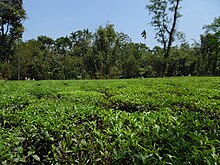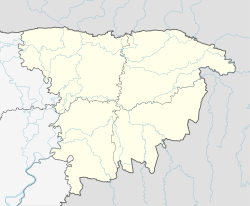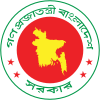|
Sylhet
Sylhet (Bengali: সিলেট; IPA: [sileʈ]) is a metropolitan city in the north eastern region of Bangladesh. It serves as the administrative center for both the Sylhet District and the Sylhet Division. The city is situated on the banks of the Surma River and, as of 2024, has a population of 999,374, making it the fifth-largest city in Bangladesh.[5] Sylhet is known for its tea plantations and natural beauty.[6] TWith a history dating back to the 14th century, the city has been ruled by various dynasties, including the Mughals, the British, and the Nawabs of Bengal. The city is also home to several important landmarks, such as the Shah Jalal Dargah, one of the holiest Islamic sites in Bangladesh, which attracts thousands of pilgrims annually.[7] Sylhet is one of the most economically important cities in Bangladesh after Dhaka and Chittagong.[8] A major commercial and financial center, Sylhet is home to several multinational companies and industries, including the tea industry, which generates a significant amount of revenue for the city. The city has a diverse population, with Bengalis, Manipuris, and other ethnic groups living together. Sylhet has diverse transport infrastructure, with a modern airport, railway station, and bus terminals that connect it to other parts of the country.[9] The city also has several educational institutions, including Sylhet Agricultural University, Shahjalal University of Science and Technology, and Sylhet Cadet College. Etymology and namesSylhet is the anglicisation of শিলহট (Śilhôṭ), one of the archaic native names for the city.[citation needed] The local name is generally thought to be directly derived from শ্রীহট্ট (Śrīhaṭṭa), the Sanskrit name of the city.[10] The city of Śrīhaṭṭa takes its name from Śrīhaṭṭanātha, the tutelary deity of the Nātha dynasty who promoted the early settlement of Nāthas in the Surma and Barak valleys between the twelfth and thirteenth centuries, founding the Śrīhaṭṭa janapada and establishing Śrīhaṭṭanātha idols across the region.[11] The later Hindu monarchs of Sylhet, such as Gour Govinda, continued to pay tribute to the deity as Hāṭkeśvara or Haṭṭanātha as evident from the Devipurana and copper-plate inscriptions.[12] HistoryIn 1303, the Sultan of Lakhnauti Shamsuddin Firoz Shah conquered Sylhet by defeating Gour Govinda.[13] Sylhet became a part of the Bengal Sultanate. In the 16th century, Sylhet was controlled by the Baro-Bhuiyan zamindars and later became a sarkar (district) of the Mughal Empire.[14] Sylhet emerged after 1612 as the Mughals' most significant imperial outpost in Bengal east of Dhaka, and its importance remained as such throughout the seventeenth century.[15] British rule began in the 18th century under the administration of the East India Company. Sylhet became a key source of lascars in the British Empire due in part to its ancient seafaring tradition. The Sylhet municipal board was established in 1867.[16] Originally part of the Bengal Presidency and later Eastern Bengal and Assam, the town became part of Colonial Assam in 1874. A devastating earthquake demolished almost the entire town on 12 June 1897 following which a modern and European model new town was built on the wreckage.[citation needed] From the beginning of the 20th century, the importance of Sylhet increased with the establishment of the tea industry.[17] In 1947, following a referendum and the partition of British India, Sylhet became part of East Pakistan.[13] In 1995, the Government of Bangladesh declared Sylhet as the sixth divisional headquarters of the country.[18] Sylhet has played a vital role in the Economy of Bangladesh. Several of Bangladesh's finance ministers have been members of parliament from the city of Sylhet. Badar Uddin Ahmed Kamran was a long time mayor of Sylhet. Humayun Rashid Choudhury, a diplomat from Sylhet, served as President of the UN General Assembly and Speaker of the Bangladesh National Parliament. In 2001, the municipality was upgraded to the Sylhet City Corporation. It was made a metropolitan city in 2009.[19] Geography and climateSylhet is located in the north eastern region of Bangladesh within the Sylhet Division, the Sylhet District, and Sylhet Sadar Upazila. Sylhet has a typical Bangladeshi tropical monsoon climate (Köppen Am) bordering on a humid subtropical climate (Cwa) at higher elevations. The rainy season runs from April to October, and is generally hot and humid with heavy showers and thunderstorms almost every day. The shorter dry season runs from November to February, with very warm and fairly clear weather. Nearly 80% of the annual average rainfall of 4,200 millimetres (170 in) occurs between May and September.[20] The city is located within a topographically distinctive region of Bangladesh characterized by dramatic hills and basins. The physiography of Sylhet consists mainly of hill soils and encompasses a few large depressions known locally as "beels," which are frequently oxbow lakes caused by tectonic subsidence during the earthquake of 1762. Geologically, the region is complex and diverse; higher-elevation regions date partly to the Plio-Miocene age. Available limestone deposits in different parts of the region suggest that the whole area was under the ocean in the Oligo-Miocene. In the last 150 years, three major earthquakes have hit the city with magnitude of at least 7.5 on the Richter Scale, most recently in 1918.[21]
  AdministrationRobert Lindsay, who served as the District Collector of Sylhet from 1778 to 1790. In his autobiography, Oriental Miscellanies: Anecdotes of Indian Life, he mentioned to Sylhet as 'a small bazaar (market)'. He wrote, "The town was then merely a small market. The inhabitants’ houses were situated on the hills and hidden behind forests and jungles."[25] Exactly 100 years after his tenure, in 1878, Sylhet was upgraded into a municipality with an approximate area of about 1.75 square kilometers.[26] The civic body of Sylhet was formed according to the Sylhet City Corporation Act, 2001, which came into effect on April 10, 2001.[27] On July 28, 2002, Sylhet Municipality board was upgraded to a City Corporation, which covering an area of 26.50 square kilometers and divided into 27 wards, and currently the city is administered by the Sylhet City Corporation.[28] On August 31, 2021, a gazette notification was issued to expand the area of Sylhet City Corporation. According to the gazette, several mouzas from four unions of Sylhet Sadar Upazila and three unions of Dakshin Surma Upazila were included in the City Corporation. Subsequently, the expanded areas were reorganized and boundaries were defined on a ward basis under Sections 29 and 30 of the Local Government (City Corporation) Act, 2009. Currently, the City Corporation consists of 42 wards and covers an area of 79.5 square kilometers.[29] At present, Sylhet is the district-headquarters as well as the divisional headquarters of the districts of Sunamganj, Habiganj, Moulvibazar and Sylhet District. The Sylhet City Corporation is responsible for the services that are provided within the city which includes traffic, roads, garbage collection, water supply, registrations and many others. The corporation consists of the Mayor and 22 other commissioners, and focuses on the development of the city.[30] Sylhet is divided into 6 metropolitan thanas (police stations), 42 wards, and 1224 mahallas.[citation needed] MilitarySylhet is strategically important for the Bangladesh Armed Forces. The Bangladesh Army's 17th Infantry Division is based at Jalalabad Cantonment in Sylhet.[31] The cantonment is also home of the School of Infantry and Tactics (SI&T) and the 1st Para-commando Battalion, an elite commando unit of the Bangladesh Army.[citation needed] HealthcareSylhet is also home to many hospitals such as the Shahid Shamsuddin Hospital District Hospital, Sylhet MAG Osmani Medical College, Jalalabad Ragib-Rabeya Medical College, North East Medical College, and Sylhet Women's Medical College.[citation needed] In 2018, Sylhet Medical University was established in the city, following the Prime Minister's order to found a medical university in each division with the goal of maintaining medical standards in colleges. According to the order, Chittagong and Rajshahi Medical University have already been established, and Sylhet Medical University is the fourth Medical University of the directive.[32][33] DemographicsAs of the 2011 Bangladesh census, Sylhet has a population of 485,138.[34] The population growth rate of the city is 1.73%, a decrease from 1.93% in 1991.[35] Sylhet has a sex ratio of 861 females to 1000 males and a literacy rate of 67.8%.[34] The majority of the population are Bengali Muslims, while significant minority population groups include the Bengali Hindus, Bishnupriya Manipuri and others.[36] Sylheti is spoken by the vast majority of the people, while Standard Bengali is the official language used by the state government and officials.[37][38][39] Ethnic minorities are 2,424 (0.45%), of which 2,040 are Manipuri. The majority of people in Sylhet are Muslims (86.5%), while other religious groups include Hindus (13.3%) and less than 0.2% of other religions, mainly Buddhists and Christians. The majority of Muslims in Sylhet are Sunnis who follow the Hanafi school of jurisprudence.[40] Significant numbers of people also follow Sufi ideals, particularly the teachings of Abdul Latif Fultali.[41] Economy
The Sylhet Metropolitan Area is one of Bangladesh's main business centres. Sylhet's economy is closely linked with the Bangladeshi diaspora, especially the British Bangladeshi community. The city receives a significant portion of the country's annual remittances, which have driven growth in real estate and construction.[42] A number of shopping centres, restaurants and hotels have opened as a result. Sylhet also relies on religious tourism, with thousands of devotees visiting its Sufi shrines annually, as well as ecotourism in its broader natural hinterland.[citation needed] Nature resorts have been built in the city's outskirts. Several important Bangladeshi companies are based in Sylhet, including Jalalabad Gas Transmission and Distribution, Sylhet Gas Fields and Alim Industries. Biman Bangladesh Airlines operates several flights from Sylhet to the United Kingdom and the Middle East. Roads connect Sylhet with the Indian states of Meghalaya and Assam. Sylhet's hinterland plays a vital role in the economy of Bangladesh. It is home to the country's largest natural gas fields, sole crude oil field,[43] largest tea plantations, rubber, palm oil, cane, agarwood[44] and citrus farms. Rice production in the region is one of the country's highest. Heavy industries include power plants, fertilizer plants, cement plants and liquefied petroleum gas plants. Other major industries in the region include ceramics, machinery and equipment, ready-made garments and pharmaceuticals. Most of the tea production in Bangladesh is based around Sylhet, much of which is eventually exported internationally.[45] UtilitiesSylhet has high rates of electricity and water shortages. According to the Power Development Board, as of 2009, Sylhet was only receiving 50 MW, half of the required demand of 100 MW. The city corporation was also supplying only 22,500 gallons of water, far less than the demand of about 65,000.[46] The major sources of water to the city are the tube wells and the Surma River.[citation needed] Tests of tube wells in Sylhet District by the Bangladesh University of Engineering and Technology in 1997 found that about 27.6% contained more arsenic than the acceptable limit set by Bangladesh of 50 micrograms per liter, and 49.2% contained more arsenic than the World Health Organization standard of 10 micrograms per liter.[47] There are about 331 registered restaurants in the city, but only 15% maintain sanitary facilities and 85% have unhygienic conditions that are unsafe for the public.[48] Media and communicationsState-owned Bangladesh Television operates a relay station headquartered in the Kazitula neighborhood.[49] From 2000 to 2002, privately owned Ekushey Television broadcast terrestrially on VHF channel 11 in Sylhet.[50] Sports Cricket is the most popular sport in Sylhet.[citation needed] The Bangladesh Premier League franchise Sylhet Strikers are based in Sylhet International Cricket Stadium (M.A.G. Osmani Stadium), which was built in 2007 and has a capacity of 18,500 spectators. The Sylhet International Cricket Stadium was renovated in 2013 specifically to host matches for the 2014 ICC World Twenty20. It is situated near lush green tea gardens on the city fringe.[51] In the National Cricket League, Sylhet Division has not won any titles but did win in the One-Day Cricket League during the 2001–02 season. Notable players from Sylhet who have played for the Bangladesh national cricket team include Rajin Saleh,[52] Enamul Haque Jr,[53] Tapash Baisya,[54] and Alok Kapali.[55] Chess player Rani Hamid was awarded the FIDE Women's International Master (WIM) title in 1985, while her son Kaiser Hamid was the captain of the Bangladesh national football team in the early 90s.[56] TransportRoadThe main transport systems used in Sylhet are cycle rickshaws, auto rickshaws (mainly known as baby-taxis or CNGs), buses, mini-buses and cars. About 80,000 rickshaws run each day within the city. Bus service prices have increased up to 30% higher, and as of 2008 prices range from Tk 4 to 15.95.[57] The N2 connects the city with Bangladesh's capital and largest city, Dhaka, as well as with many other parts of the country. The N2 highway is also part of the Asian Highway Network's two longest routes, AH1 and AH2. AirSylhet is served by Osmani International Airport, located at the north of the city. It is Bangladesh's third busiest airport, and it became an international airport due to demand driven by expatriate Bangladeshis and their families living in the United Kingdom and the United States. The most prevalent airlines at the airport are Biman Bangladesh Airlines, US-Bangla Airlines and Novoair. Osmani International Airport received its first international arrival on 3 November 2002, with a Biman plane arriving from Kuwait via Abu Dhabi en route to Dhaka.[58] Sylhet's first direct international flight arrived on 15 March 2017 when a Flydubai direct flight from Dubai landed at the airport.[59] Work began in 2006 to upgrade the airport to international standards, including a new terminal building, a jetway, a taxiway, and expansion of the runway to accommodate wide-bodied aircraft.[60] In May 2007, Biman announced direct Hajj flights originating from the airport later that year.[61] As of 2020, Biman Bangladesh operates direct flight to London from Sylhet.[62] All Bangladeshi airlines operate regular domestic flights to Dhaka and Biman operates regular domestic flights to Cox's Bazar.[63] In response to the increase in passenger and cargo demand at the airport, work began in 2020 on a new 34,919 square metres (375,860 sq ft) international passenger terminal building, as well as a cargo building, a control tower, parking areas, and a taxiway.[64][65] Rail The Sylhet railway station is the main railway station providing trains on national routes operated by the state-run Bangladesh Railway. Some train routes originating or terminating in Sylhet include the following. Towards Dhaka
Towards Chittagong
Towards Akahura
EducationThere are two public universities in Sylhet: Shahjalal University of Science and Technology and Sylhet Agricultural University. There are also private universities such as Leading University and Metropolitan University.[66][67] Other prominent colleges and schools in Sylhet include Jalalabad Cantonment Public School and College, Jalalabad Ragib Rabeya Medical college, Pathantula Parkview Medical College, MAG Osmani Medical College, Sylhet, Sylhet Women's Medical College, North East Medical College, Sylhet Engineering College,[68] Sylhet Cadet College, Murari Chand College,[69] Institute of Health Technology, Sylhet,Border Guard Public School And College, Scholarshome, Blue Bird High School and College, Sylhet Science And Technology College, Sylhet Polytechnic Institute, and Sylhet Government Women's College. Notable peopleTwin towns – sister citiesSylhet is twinned with:[citation needed] As of 2009, Sylhet has friendly relations with: The friendship link with St Albans was established in 1988, when the St Albans' district council supported a housing project in Sylhet as part of the International Year of Shelter for the Homeless. Sylhet was chosen because it is the home region for a large ethnic minority population in St Albans.[70] In March 2009 the Mayor of Sylhet, Badar Uddin Ahmed Kamran, signed a Memorandum of Understanding to form another friendship link between Sylhet and Rochdale, home to around 10,000 people with Sylheti heritage. The Mayor of Sylhet signed it alongside the Mayor of Rochdale, Cllr Keith Swift, at the Sylhet City Corporation.[citation needed] See alsoReferences
External linksWikiquote has quotations related to Sylhet. Wikimedia Commons has media related to Sylhet.
|
||||||||||||||||||||||||||||||||||||||||||||||||||||||||||||||||||||||||||||||||||||||||||||||||||||||||||||||||||||||||||||||||||||||||||||||||||||||||||||||||||||||||||||||||||||||||||||||||||||||||||||||||||||||||||||||||||||||||||||||||||||||||||||||||||||||||||||||||||||||||||||||||||||||||||||||||








